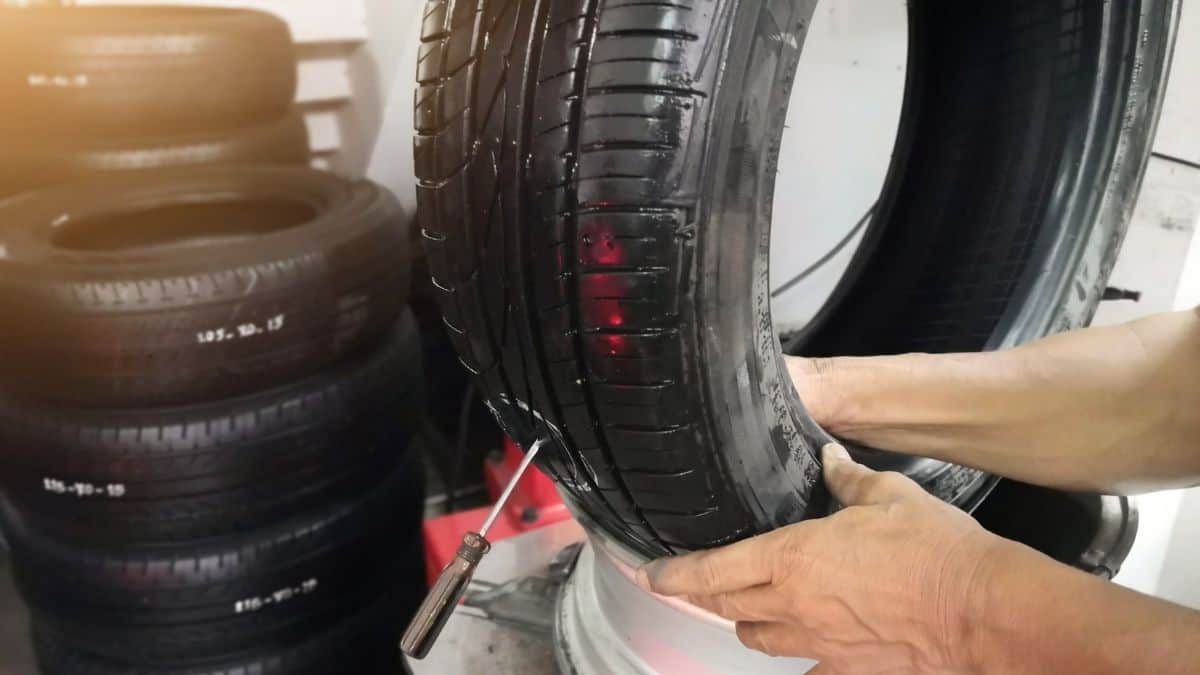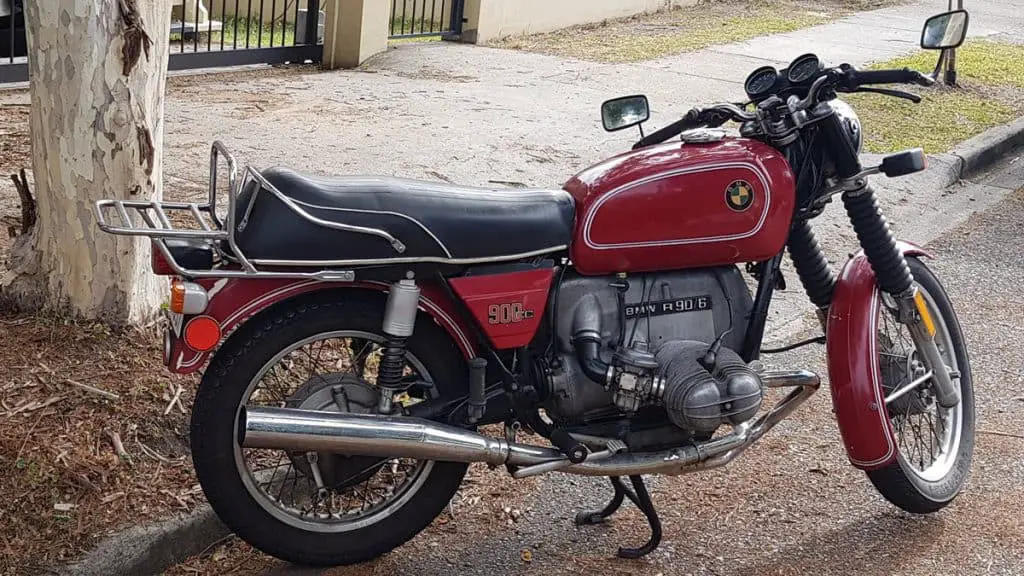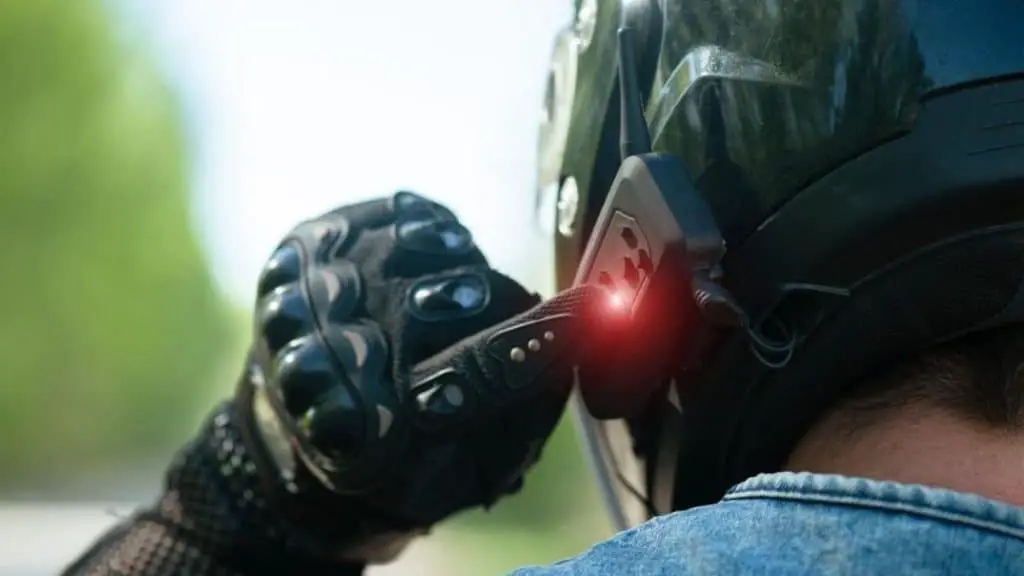Hole in My Tire: Can You Plug Or Patch A Motorcycle Tire?
When you have ridden enough miles on your motorcycle, there’s one thing you know for sure.
A flat tire is as inevitable as a hangover after a New Year’s eve.
(And how the devil do punctures always happen with such perfect timing?)
So you have a nail sticking into the tire. Can you fix a flat tire on a motorcycle by patching or plugging?
The answer isn’t so simple.
Yes, you can plug or patch a motorcycle tire. But you need to be aware of the safety aspects of such a repair.
This is where you need to differentiate between an emergency fix and a long-term solution.

Let’s take a closer look at the subject to clear things up.
How Can You Fix a Flat Tire on a Motorcycle?
Before you use a motorcycle tire plug or a patch, you need to know whether the tires have tubes or are tubeless.
Tubeless tires are repaired by patching or plugging. Whereas tires with tubes can only be patched.
Generally, both methods are used together to ensure a more reliable repair job. More on that later.
The good news is most modern bikes come with radial tubeless tires. These tires are more puncture resistant than the tires of yesteryear. They form an airtight casing and have an inner lining to prevent punctures. Brands have also started adding additional layers of protection after the main layer of rubber to make tires more durable.
That makes them more resistant to blowouts from a nail intrusion. But the tires will still get punctured and lose air slowly.
Plugging is usually done by using a repair kit. It’s best to buy a high-quality kit that comes with T-handle tools, and devices for reinflating the tire.
Once the foreign object is taken out from the tire, the hole is cleaned and prepared for inserting a motorcycle tire plug. Then, a rubber string or a plug is inserted into the hole. Lastly, the area is patched by using rubber cement.
On the other hand, things aren’t so simple for tube-type tires. You need to take the wheel off to replace or repair the tube. If you’re carrying tools like a tire lever, tire lubes, a pressure gauge, and a valve stem removal tool along with a repair kit, you can attempt it.
The best idea is to call for a towing vehicle to take the bike to a shop.
But is it true that many tire shops refuse to plug or patch a motorcycle tire?
Thought you’d never ask!
With a motorcycle tire plug and patch repair, the liability concerns are higher. If a repaired tire blows out, it can have severe consequences for the rider.
Another reason is, you guessed it right, profitability. A repair shop will make more money by selling a new tire than by performing a tubeless motorcycle tire repair.
But one thing’s for sure. Their actions aren’t entirely without reason.
Is Patching A Motorcycle Tire Safe?
The simple truth is, you can always repair tires by plugging or patching. In fact, many of us have done it during an emergency.
But when it comes to safety, the answer isn’t so simple.
There are plenty of opinions on the topic depending on who you ask.
Believe it or not, many of the top tire companies don’t recommend tire repairing practices under any circumstances. As per them, the safest solution is to call a tow truck, head to a repair shop, and get your tire replaced.
Why so?
You’ve heard this a million times.
Tires are vital for the stability of a motorcycle more than that of a vehicle. Sudden air loss and reduction of the contact patch at high speeds can be dangerous.
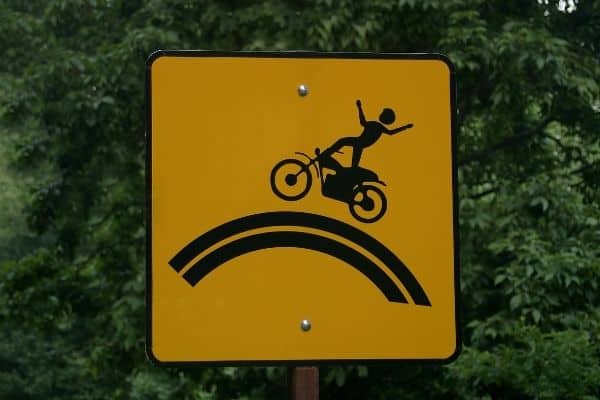
Tire manufacturers say, there are too many variables involved with a repair that can compromise ride safety. So repairing a tire, even in an emergency, can be highly risky.
The main reason is related to preserving the integrity of the tire rubber. While many riders swear that a plug-only repair has held up for hundreds of miles, tire experts will consider such a repair unsafe.
A patch repair may not fill the entire void left behind in the rubber by a foreign object. As a result, air and moisture can enter the inside of the tire.
This can lead to corrosion and affect the integrity of the tire structure. The metal belts inside the tire are affected as well. Since most modern tires come with steel belts, rusting can be a major issue.
This inside damage could lead to tread separation during riding. Moreover, the rider may not be aware of the slow air leakage from a tubeless tire. The air can even seep into the damaged rubber and fasten the process of tread separation.
The effects can be the same with a plug-only repair.
Here are some other points that you need to keep in mind before plugging a motorcycle tire:
- Deep gashes measuring 1/4th of an inch or more on the tire surface can damage the inner layers of the tire. Since the integrity of the tire is compromised, such tires should not be patched.
- Ideally, the repair area should be limited to the crown of the tire. This includes around 75% of the tread area.
- Perish any thoughts of repairing damage to the sidewall or the shoulder of the tire. This area is non-repairable. It is because the sidewalls are thinner and have more flexibility than the tread. And since the sidewall flexes more than the tread area, there is less chance of the repair holding. So, replacing the tire is the only option.
- DO NOT OVERLAP REPAIRS. If a spot that was repaired earlier gets damaged again, it’s time to replace the tire.
- Damages like tears, slices, and oblong-shaped cuts shouldn’t be repaired. Only round holes not more than 7 millimeters in diameter are fit for repair.
- Don’t repair a tire in case the tread has worn out or the depth indicators have reached 2/32-inch. The tread simply doesn’t have enough depth left for an effective repair.
And let’s not forget, manufacturers use the term “improper repair” during any litigation that may arise from the failure of a tire.
(No repairs! You have got to be kidding me. I just spent $200 on this top-of-the-line tire!)
Hang on a minute. Don’t say goodbye to tire repairs yet.

There are some manufacturers who mention that tires can be repaired in an emergency situation. But only a professional can do it in the right manner.
For example, here’s what Dunlop recommends:
“Dunlop recommends only permanent plug-patch repairs of small (maximum 1/4-inch diameter) tread-area punctures from within the dismounted tire by a qualified tire repair shop or motorcycle dealer. Never perform an exterior repair and never use an inner tube as a substitute for a proper repair. Speed should not exceed 50 mph for the first 24 hours after repair, and the repaired tire should never be used over 75 mph.”
Note, the use of liquid sealants for tire repair is not recommended by Dunlop or any other top tire manufacturers.
This is why the National Highway Traffic Safety Administration (NHTSA) recommends a combination repair as the best option.
Once the puncture is located, the plug and the patch is applied to create a tight and uniform seal with the tire rubber.
This serves a dual purpose.
The plug seals the puncture hole and prevents the air from escaping. The patch prevents the outside air and moisture from attacking the tire material.
It all boils down to this…
Plugging or patching a motorcycle tire in the wrong manner can be risky. If you’re forced to make an emergency repair, ride slowly till you reach the garage.
And keep a close watch on the tire pressure at all times. Tubeless tires lose air slowly. That should give you enough time to safely stop the bike if the tire fails.
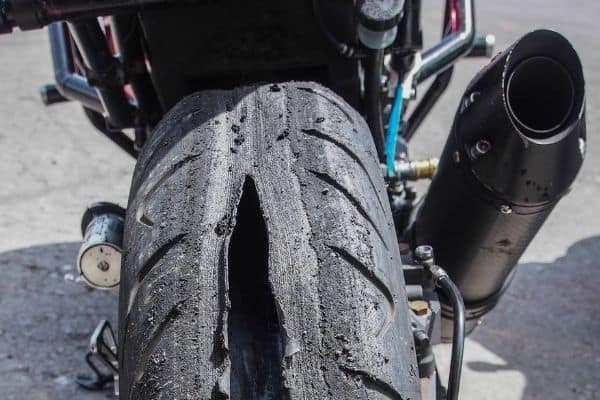
Even so, this isn’t a permanent solution. Get the tire thoroughly checked (especially the interiors) and choose a permanent fix as per professional advice.
And get this: To repair a flat tire, you need to be familiar with the process. If you’ve never patched or plugged a tire before, even if you are stuck on a deserted road with a flat tire, DO NOT attempt it.
Simply call or wait for help. I would suggest you include roadside assistance in your motorcycle insurance plan.
(Let’s say I agreed to this. But, can I still change my mind later?)
One thing is, you can’t determine the full extent of the damage from the external hole. Also, the results of a patch done by inexperienced hands can be too unpredictable.
There are riders who will tell you how plugging or patching worked for them without any issues. But that doesn’t mean it will work for you.
I know being stranded on the roadside sucks. But let’s be honest; it’s better than risking an accident and spending thousands of dollars on medical bills!
Frequently Asked Questions
Is patching a motorcycle tire safe?
Any repair process for motorcycle tire plugging or patching isn’t a permanent solution. The process isn’t considered safe by many tire manufacturers. The safest solution is to take the tire to a shop for thorough checking and get it replaced.
How much does it cost to patch a motorcycle tire?
A professional repair service for a motorcycle tire can cost between $10 to $20. A motorcycle tire repair kit can cost you between $30 to $60.
How long can you ride on a patched motorcycle tire?
You shouldn’t ride on a patched motorcycle tire unless it’s absolutely necessary. A patched tire should only be used as a temporary solution to take you home. Make sure that you know all about the limitations of repairing motorcycle tires before attempting it.

